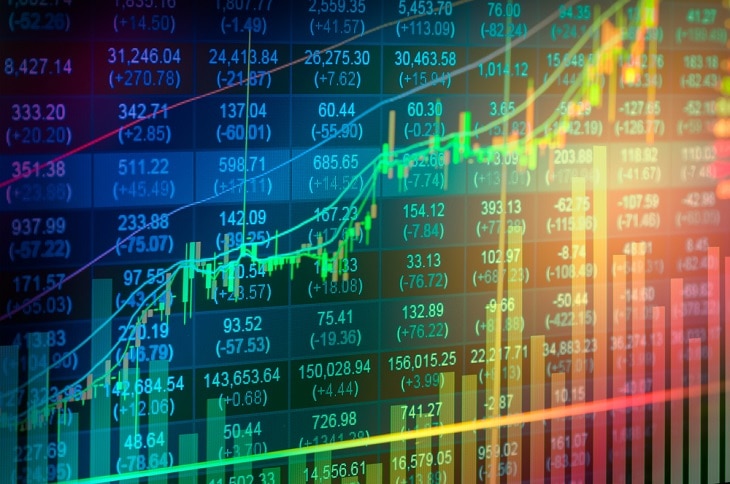Jasmine Birtles
Your money-making expert. Financial journalist, TV and radio personality.


The S&P 500 has just surpassed the 5,000 mark for the first time in its 67-year history.
So what is driving this stock boom across the pond? And should investors who have exposure to American stocks, be worried that we’re on the cusp of another asset bubble?
Click on a link to head straight to a specific section, or scroll down for all of the details…
On Thursday 22 February the S&P 500 surpassed the 5,000 mark for the first time following its largest daily gain in over a year (2.11%). The index, which tracks 500 of the largest companies listed on American stock exchanges, closed the day at 5,087.03.
It was a similar story for the Dow Jones Industrial Average which also hit a record high on Thursday. The index, which encompasses 30 major U.S. blue-chip companies, closed the day at 39,069.11, following a 1.18% daily rise.
It should be noted that both of these US indexes have similar levels of volatility. This is why they often rise and fall in tandem.
Sadly – for UK investors at least – the boom across the pond didn’t translate into gains for British-listed firms. By the morning of Friday 23 February the UK’s largest share index, the FTSE 100, had hardly moved, rising a modest 0.07% after a flat week.
So what is driving the recent surge in stock values over in the U, S, of A? Let’s take a closer look…
All ‘Magnificent 7‘ stocks are constituents of the S&P 500 and, despite making up less than 2% of stocks in the index, the group accounts for around 30% of the S&P 500’s entire weighting. Pretty impressive!
We’re telling you this because it was one Magnificent 7 stock that was responsible for sending the S&P 500 into overdrive on Thursday… Nvidia.
Founded in 1993, Nvidia was a ‘relatively’ unknown name until the past 12 months or so, when the company soon began appearing in a number of headlines following the unprecedented boom in artificial intelligence (AI).
To cut a long story short, Nvidia was once known for making chips to improve the graphics for computer games. However, the company’s subsequent foray into AI hardware chips is the reason behind its value skyrocketing over recent months, particularly since Q2 2023. Despite the relative newness of AI, the technology is progressing at a frighteningly fast pace, and Nvidia has now established itself as a superpower in the sector.
On Thursday, Nvidia’s value soared $277 billion which was the biggest-ever single-day increase in a company’s stock market value. The spike came after the firm released of better-than-expected forecasts which put to bed any belief among investors that the AI boom has already peaked.
It should also be noted that alongside the rise in Nvidia stock, other AI-related stocks also climbed on Thursday, including that of rival chip-maker Marvell Technology (up 6%), and chip-designer, Synopsys (up 7%).
For those who suffer from flashbacks, you may remember the dotcom bubble where tech stock values ended up losing a collective $5 trillion back in the early 2000s.
“But this time it’s different…”
It’s a sentence often repeated by investors in the know, or at least those who *think* they’re in the know. But in reality, nobody really knows whether the current tech bull run will continue at full speed, or whether we’re seeing the ‘greater fool theory’ in action.
What we do know, however, is that AI is all very exciting right now, and there’s undoubtedly billions or trillions to be made from the sector. The question is… is the market getting a little too carried away?
Potentially. After all, much investing is just speculation, and the valuations made by ‘Mr Market’ can soon change whenever new information comes into play. We’ve already seen this happen with Nvidia of course. Just five years ago, you could have bought a single share in the company for just $39 (£30.75). Nowadays, one share will set you back a whopping $785 (£618) at the time of writing. Such dramatic changes in value can happen in the opposite direction of course…
In short, if the profits from these booming tech companies do not materialise as expected, then we can expect to see their values flatline or slump in future as venture capital dries up with it. There is also a possibility that the sector is indeed in a bubble in which case we’ll see a lot of tears.
Whatever your opinion on the future of tech stocks, it’s worth bearing in mind a quote from our old friend, Warren Buffet, with regards to buying assets that have recently shot up:
“Be fearful when others are greedy and greedy when others are fearful”
In the current climate, there’s little doubt that the legendary 93-year old investor would err on the side of caution when it comes to investing in tech right now but, then again, who knows?
The S&P 500 is a major US stock market index which tracks the performance of 500 American-listed firms. The index is known for being tech-heavy, and includes a number of mammoth constituents – Apple, Amazon, Microsoft, Tesla… the list goes on.
For investors looking to gain general exposure to big-name US stocks, investing in a S&P 500 fund is arguably the best, and easiest way to go about it.
To learn more about the share index that everybody is talking about right now, take a look at our article that explains how UK investors can invest in the S&P 500. Just remember that when investing the value of your investments can fall and there’s no guarantee of success.
Want to learn more about investing? Sign up for our fortnightly MoneyMagpie Investing Newsletter. It’s free and you can unsubscribe at any time.
Disclaimer: MoneyMagpie is not a licensed financial advisor and therefore information found here including opinions, commentary, suggestions or strategies are for informational, entertainment or educational purposes only. This should not be considered as financial advice. Anyone thinking of investing should conduct their own due diligence. When investing your capital is at risk.
Direct to your inbox every week
New data capture form 2023
"*" indicates required fields

Leave a Reply